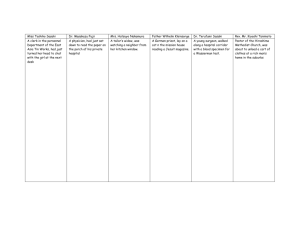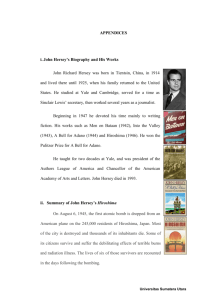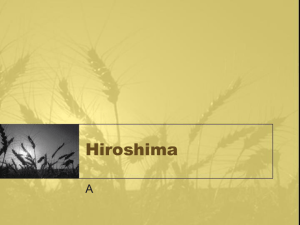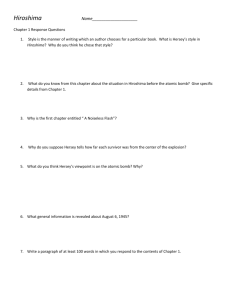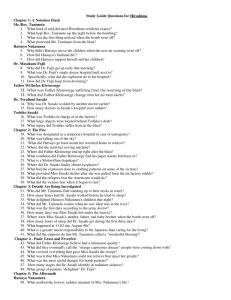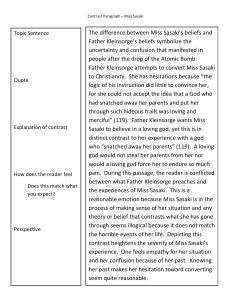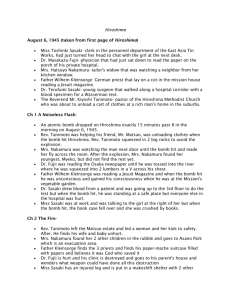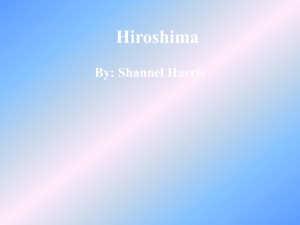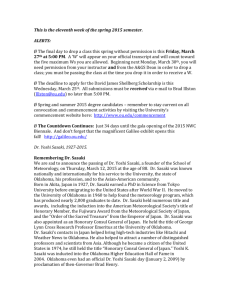Study Guide Questions for Hiroshima - Mrs. Lisa Gallagher
advertisement
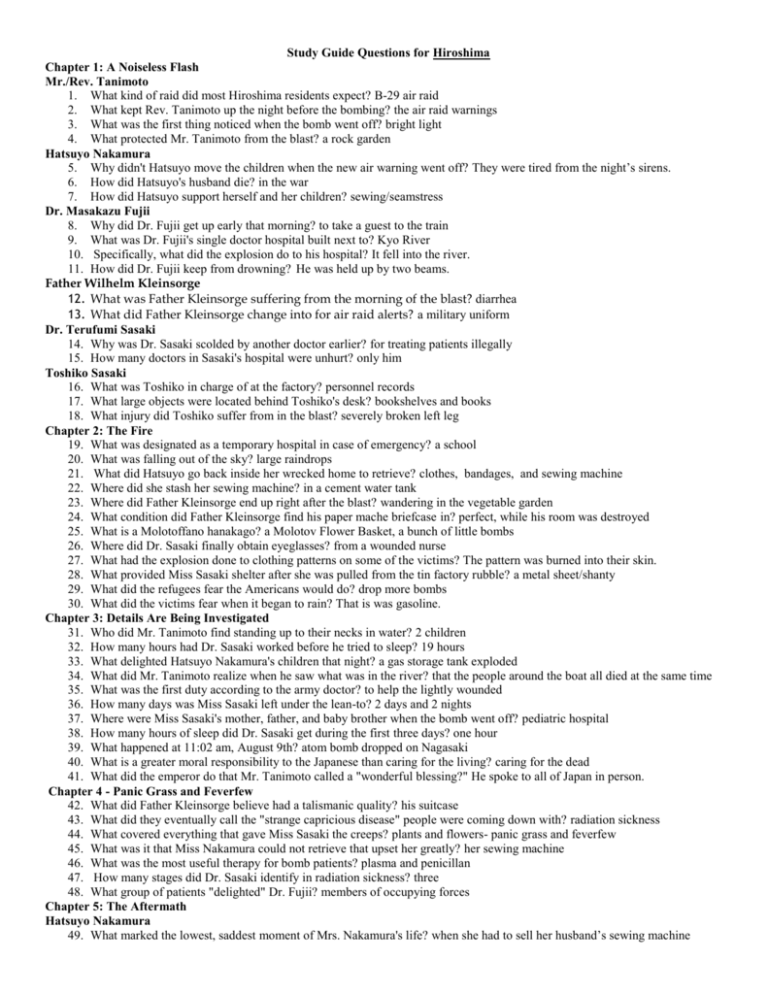
Study Guide Questions for Hiroshima Chapter 1: A Noiseless Flash Mr./Rev. Tanimoto 1. What kind of raid did most Hiroshima residents expect? B-29 air raid 2. What kept Rev. Tanimoto up the night before the bombing? the air raid warnings 3. What was the first thing noticed when the bomb went off? bright light 4. What protected Mr. Tanimoto from the blast? a rock garden Hatsuyo Nakamura 5. Why didn't Hatsuyo move the children when the new air warning went off? They were tired from the night’s sirens. 6. How did Hatsuyo's husband die? in the war 7. How did Hatsuyo support herself and her children? sewing/seamstress Dr. Masakazu Fujii 8. Why did Dr. Fujii get up early that morning? to take a guest to the train 9. What was Dr. Fujii's single doctor hospital built next to? Kyo River 10. Specifically, what did the explosion do to his hospital? It fell into the river. 11. How did Dr. Fujii keep from drowning? He was held up by two beams. Father Wilhelm Kleinsorge 12. What was Father Kleinsorge suffering from the morning of the blast? diarrhea 13. What did Father Kleinsorge change into for air raid alerts? a military uniform Dr. Terufumi Sasaki 14. Why was Dr. Sasaki scolded by another doctor earlier? for treating patients illegally 15. How many doctors in Sasaki's hospital were unhurt? only him Toshiko Sasaki 16. What was Toshiko in charge of at the factory? personnel records 17. What large objects were located behind Toshiko's desk? bookshelves and books 18. What injury did Toshiko suffer from in the blast? severely broken left leg Chapter 2: The Fire 19. What was designated as a temporary hospital in case of emergency? a school 20. What was falling out of the sky? large raindrops 21. What did Hatsuyo go back inside her wrecked home to retrieve? clothes, bandages, and sewing machine 22. Where did she stash her sewing machine? in a cement water tank 23. Where did Father Kleinsorge end up right after the blast? wandering in the vegetable garden 24. What condition did Father Kleinsorge find his paper mache briefcase in? perfect, while his room was destroyed 25. What is a Molotoffano hanakago? a Molotov Flower Basket, a bunch of little bombs 26. Where did Dr. Sasaki finally obtain eyeglasses? from a wounded nurse 27. What had the explosion done to clothing patterns on some of the victims? The pattern was burned into their skin. 28. What provided Miss Sasaki shelter after she was pulled from the tin factory rubble? a metal sheet/shanty 29. What did the refugees fear the Americans would do? drop more bombs 30. What did the victims fear when it began to rain? That is was gasoline. Chapter 3: Details Are Being Investigated 31. Who did Mr. Tanimoto find standing up to their necks in water? 2 children 32. How many hours had Dr. Sasaki worked before he tried to sleep? 19 hours 33. What delighted Hatsuyo Nakamura's children that night? a gas storage tank exploded 34. What did Mr. Tanimoto realize when he saw what was in the river? that the people around the boat all died at the same time 35. What was the first duty according to the army doctor? to help the lightly wounded 36. How many days was Miss Sasaki left under the lean-to? 2 days and 2 nights 37. Where were Miss Sasaki's mother, father, and baby brother when the bomb went off? pediatric hospital 38. How many hours of sleep did Dr. Sasaki get during the first three days? one hour 39. What happened at 11:02 am, August 9th? atom bomb dropped on Nagasaki 40. What is a greater moral responsibility to the Japanese than caring for the living? caring for the dead 41. What did the emperor do that Mr. Tanimoto called a "wonderful blessing?" He spoke to all of Japan in person. Chapter 4 - Panic Grass and Feverfew 42. What did Father Kleinsorge believe had a talismanic quality? his suitcase 43. What did they eventually call the "strange capricious disease" people were coming down with? radiation sickness 44. What covered everything that gave Miss Sasaki the creeps? plants and flowers- panic grass and feverfew 45. What was it that Miss Nakamura could not retrieve that upset her greatly? her sewing machine 46. What was the most useful therapy for bomb patients? plasma and penicillan 47. How many stages did Dr. Sasaki identify in radiation sickness? three 48. What group of patients "delighted" Dr. Fujii? members of occupying forces Chapter 5: The Aftermath Hatsuyo Nakamura 49. What marked the lowest, saddest moment of Mrs. Nakamura's life? when she had to sell her husband’s sewing machine 50. 51. 52. 53. 54. What term did the Japanese shy away from when referring to those who went through the blasts? hibakushu How did non-hibakusha employers treat survivors? with prejudice because they were sick What did Mrs. Nakamura take up for pleasure after she retired? embroidery and dressing Japanese dolls What was Mrs. Nakamura's state of mind when she returned home from the Yasukuni Shrine? uneasy What happened to Mrs. Nakamura when she danced on the Emperor's birthday 4 decades later? she was woozy and went to the hospital Dr. Terufumi Sasaki 55. What would be Dr. Sasaki's life work? doctor 56. It took most interns 5 years to get their doctoral degree; how long did it take Dr. Sasaki? 10 57. What often happened when keloid scars were removed? they often came back 58. What disease was much higher in hibakusha than normal? leukemia 59. What was Dr. Sasaki's one regret? He couldn’t identify all the dead at the Red Cross Hospital. Father Wilhelm Kleinsorge 60. What did one of Father Kleinsorge's colleagues jokingly say about him and Japan? He was married to Japan. 61. What did Father Kleinsorge file for and get? Japanese citizenship 62. What was Father Kleinsorge's most disturbing complaint? a weird infection in his fingers Toshiko Sasaki 63. What new blow did Toshiko Sasaki experience? Her fiancé left her. 64. What did the surgeries finally do for her legs? They were both the same length and she could walk almost normally. 65. Where did Sasaki go when she knew she would never marry? to a convent to become a nun 66. What was her greatest gift? her ability to help inmates die in peace 67. What was one of the happiest moments of her life? She was honored at a banquet in 1980 for being a nun for 25 years. Dr. Masakuzu Fujii 68. What was Dr. Fujii's hobby for years? studying foreign languages 69. How did her obtain penicillin for his patients? through his occupational friends 70. How did Dr. Fujii deal with psychological effects of the bomb? pleasure principle- he enjoyed life to the fullest Rev. Kiyoshi Tanimoto 71. Where did anger of many hibakusha "modulate" toward? the Japanese government 72. What did Rev. Tanimoto realize he needed to build? a center where the experience of the bomb could be studied 73. What did American occupation personnel do to supply depots? 74. Where was Rev. Tanimoto invited to raise money? America 75. What show did Mr. Tanimoto find himself featured on? This Is Your Life
